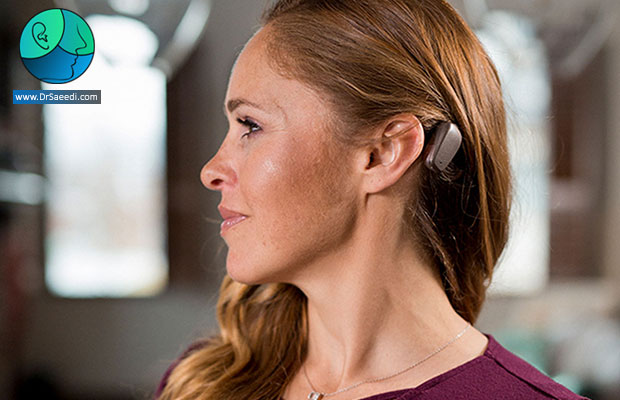سمعک متصل به استخوان (باها) چیست؟
سمعک متصل به استخوان یا سمعک باها (BAHA)، وسیلهای است که صدا را از طریق لرزش جمجمه و با دور زدن پرده گوش و استخوانهای شنوایی گوش میانی منتقل میکند. ارتعاش جمجمه منجر به فشردهسازی و انبساط گوش داخلی و در نتیجه درک صدا میشود.
سمعک باها برای دو گروه از بیماران دارای دو نوع کمشنوایی زیر که قادر به استفاده از سمعک معمولی نیستند به کار برده میشود:
- کمشنوایی انتقالی؛ آترزی مادرزادی حفره ماستوئید و عفونت مزمن حاد شده به دلیل استفاده از سمعک
- کمشنوایی عصبی؛ ناشنوایی ناشی از جراحی (به عنوان مثال، برداشتن نوروم آکوستیک و لابیرنکتومی)، آسیب و ویروس
همچنین براساس مطالعه ای که در سال ۲۰۱۷ انجام شد، سمعک متصل به استخوان باها می تواند به طور موثری به بازتوانی افراد مبتلا به ناشنوایی یکطرفه کمک کرده و کیفیت زندگی آن ها را افزایش دهد که این نتایج با مطالعاتی که بعدتر انجام شدند نیز تایید گردید. به طوریکه در سال ۲۰۲۲ نتیجه مطالعه ای که در دپارتمان جراحی گوش و حلق و بینی دانشگاه کیو ژاپن انجام شد نشان داد که سمعک باها در مقایسه با سایر روش های موجود از جمله سمعک های هدایت غضروفی در دریافت و لوکالیزه کردن صدا عملکرد بهتری دارد.
سمعک باها چگونه کار میکند؟
سمعکهای قابل کاشت استخوانی دارای دو قسمت هستند؛ ایمپلنت تیتانیوم و پردازشگر صدای خارجی. میکروفون خارجی و پردازنده صوتی، صداها را دریافت کرده و با تبدیل صدا به لرزش، آنها را به ایمپلنت انتقال میدهد.
ایمپلنت تیتانیوم (پیچ) با یک جراحی کوچک در پشت گوش قرار میگیرد. این ایمپلنت در حدود 4 میلی متری لوح خارجی استخوان جمجمه قرار گرفته و معمولاً بعد از گذشت 3-4 ماه به بافت استخوانی جوش میخورد. هنگامی که ایمپلنت به طور کامل به جمجمه متصل شد، یک پردازشگر صوتی خارجی کار گذاشته میشود.
مزایای سمعک باها(متصل به استخوان)
- سمعک باها، یک گزینه عالی بدون نیاز به جراحی برای کاشت حلزون است که میتواند به سادگی در کلینیک به خصوص برای کودکان ناشنوا اعمال شود.
- سمعک قابل کاشت استخوانی برای افرادی که یک گوش سالم دارند، بهترین عملکرد را دارد. به همین دلیل افرادی که به طور معمول بیشترین بهره را از سمعک باها میبرند؛ شامل کسانی هستند که ناهنجاریهای شدید گوش خارجی یا میانی دارند و یا فقط یک گوششان از ناشنوایی رنج میبرد.
- دستگاه هیچ گونه فشاری به پوست و جمجمه شما وارد نمیکند.
- جراحی سمعک متصل به استخوان ساده است؛ بنابراین آسیب بیشتری به شنوایی وارد نمیکند.
- سمعک باها، شنوایی بهتری را برای بیماران مبتلا به ناشنوایی انتقالی (مانند کمشنوایی ناشی از اتوسکلروز)، فراهم میکند.
- سمعک متصل به استخوان برای کودکانی که به دلیل تغییر شکل گوش خارجی، شرایط پوستی یا ترشحات مزمن گوش نمیتوانند از سمعک معمولی استفاده کنند، بسیار مناسب است.
- سمعک قابل کاشت استخوانی صداهای بهتری نسبت به سایر سمعکها تولید میکند.
چه کسانی واجد شرایط سمعک باها هستند؟
افرادی که بیش از پنج سال دارند و به دلایل زیر دچار کمشنوایی شدند:
- بیماری منیر
- کلستئاتوم
- التهاب مزمن گوش میانی
- کمشنوایی ناگهانی
- آترزی مادرزادی
- نقص مادرزادی مجرای گوش یا گوش میانی
- اختلال عملکردی گوش میانی
- نوروم آکوستیک
- عفونت مجرای گوش
جراحی سمعک متصل به استخوان(سمعک باها)
جراح پس از ایجاد برش خطی یا U شکل به استخوان پشت گوش میرسد. پس از آن جراح یک سوراخ در استخوان ایجاد میکند که عمق سوراخ به ضخامت استخوان بستگی داشته و معمولاً حدود 3 تا 4 میلی متر است. وقتی سوراخ کردن به پایان رسید، جراح با استفاده از دستگاه خاصی سوراخ را عریض میکند.
سپس جراح یک ایمپلنت تیتانیوم کوچک را در استخوان ماستوئید قرار میدهد. انواع مختلفی از سمعکهای متصل به استخوان وجود دارد؛ برخی از آنها ممکن است دارای یک تکیهگاه کوچک باشند که میتواند به قسمت خارجی دستگاه متصل شود. برای برخی از بیماران مبتلا به نوروم آکوستیک نیز سمعک باها در حین عمل تومور عصب شنوایی کاشته میشود.
 دوره جراحی و انواع بیهوشی بسته به نوع جراحی، متفاوت است. جراحی معمولاً تحت بیهوشی عمومی انجام میشود؛ البته این عمل با بیحسی موضعی نیز امکانپذیر است. اگر جراح یک عمل جراحی کم تهاجمی را انتخاب کند، این عمل تحت بیحسی موضعی حدود 15 دقیقه طول میکشد. بعد از گذشت دو هفته از پانسمان و کلاهک ترمیم، پانسمان و بخیهها برداشته میشوند تا به پوست پیوندی هوا برسد. سپس، پماد آنتی بیوتیک به مدت چند هفته استفاده میشود.
دوره جراحی و انواع بیهوشی بسته به نوع جراحی، متفاوت است. جراحی معمولاً تحت بیهوشی عمومی انجام میشود؛ البته این عمل با بیحسی موضعی نیز امکانپذیر است. اگر جراح یک عمل جراحی کم تهاجمی را انتخاب کند، این عمل تحت بیحسی موضعی حدود 15 دقیقه طول میکشد. بعد از گذشت دو هفته از پانسمان و کلاهک ترمیم، پانسمان و بخیهها برداشته میشوند تا به پوست پیوندی هوا برسد. سپس، پماد آنتی بیوتیک به مدت چند هفته استفاده میشود.
هزینه جراحی سمعک باها(متصل به استخوان)
هزینه جراحی سمعک استخوانی باها شامل هزینه خود سمعک و هزینه کاشت آن است. قیمت سمعک استخوانی با توجه به برند سازنده و نوسانات ارزی متغیر است. برای دیافت مشاوره رایگان و اطلاعات بیشتر درباره هزینه کاشت سمعک متصل به استخوان (باها) میتوانید با مطب دکتر معصومه سعیدی تماس بگیرید.
مراقبتهای بعد از جراحی سمعک کاشت استخوانی
بعد از جراحی، زخم باید به مدت 5 تا 7 روز خشک بماند. بنابراین بیمار در اولین هفته پس از جراحی نباید استحمام کند. بعد از گذشت یک هفته، با استفاده از برس مخصوص اطراف زخم را میتوانید تمیز کنید. بعد از هر استفاده از برس باید آن را با استفاده از آب گرم و صابون تمیز کرده و بگذارید خشک شود. به خاطر داشته باشید که باید هر سه ماه یکبار برس را تعویض کنید. موهای اطراف زخم باید همیشه کوتاه باشد تا از ایجاد اختلال در شنوایی جلوگیری شده و احتمال عفونت، کاهش یابد.BAHA Surgery Aftercare
معایب سمعک متصل به استخوان
معایب سمعک کاشت استخوانی شامل موارد زیر است:
- احتمال تحریک پوست در اطراف سمعک باها وجود دارد.
- در بعضی موارد، استخوان اطراف دستگاه رشد نمیکند و در نتیجه از بین میرود.
- تمیز کردن ناحیه نزدیک سمعک برای کودکان دشوار است.
لوازم جانبی سمعک کاشت استخوانی
بعد از جراحی سمعک باها میتوانید از لوازم جانبی مختلفی استفاده کنید که برخی از آنها جنبه کاربردی دارند و در زندگی به شما کمک خواهند کرد. تعدادی از لوازم جانبی برای شخصیسازی ظاهر دستگاه مورد استفاده قرار میگیرند و صرفاً جنبه تزئینی دارند. در حالی که برخی دیگر کاربردی هستند و به طور مثال میتوانند از طریق بلوتوث به تلفن هوشمند برای برقراری تماس تلفنی متصل شوند.
تفاوت سمعک متصل به استخوان و کاشت حلزون
سمعک باها و کاشت حلزون هر دو برای درمان کم شنوایی استفاده میشوند. با این حال، سمعک باها برای افرادی است که کمشنوایی انتقالی و مختلط یا یک گوش ناشنوا دارند؛ در حالی که کاشت حلزون گوش برای موارد شدید کاهش شنوایی حسی عصبی یا آسیب گوش داخلی است.
چرا سمعک کاشت استخوانی با دکتر سعیدی؟
دکتر معصومه سعیدی یک جراح متخصص در گوش و حلق و بینی و دارای رتبه اول در آزمون ورودی بورسیه دانشگاهی است. دکتر سعیدی در طول 12 سال تجربه خود به عنوان یک جراح متخصص بیش از 5000 عمل جراحی پیچیده از جمله جراحی کاشت سمعک استخوانی باها را انجام داده است. دکتر سعیدی همچنین دورههای تخصصی بسیاری را در کشورهایی مانند آلمان، لهستان، کرهجنوبی، فرانسه، پرتغال، مالزی و سایر کشورها گذرانده است. وی همچنین استادیار گوش و حلق و بینی در دانشگاه بقیه الله تهران است.



سلام پسر من از سمعک باها استفاده میکنه متأسفانه چند روزی هست که پین متصل بخ آهنرباش خراب شده کجا میتونم ببرم برای تعمیر ممنون میشم پاسخ بدید
سلام. معمولاً بهترین جا برای تعمیر سمعک، همان مرکزی است که سمعک را از آن خریداری کردهاید. اما اگر دسترسی به آن مرکز ندارید، بسته به مدل سمعک، میتوانید به مراکزی که از برند مشابه استفاده میکنند مراجعه کنید یا با نمایندگی رسمی برند تماس بگیرید تا سمعک را تعمیر کنند.
سلام خانم دکتر من دچار سکته گوش شدم و گوش سمت راستم کلا شنوایی نداره به موقع هم کورتون تراپی کردم هم خوراکی هم تزریق گفتن عصب گوش از بین رفته یه روز بقه الله به زور وقت گرفتم شانس کنسل کرده بودین رفتم پیش دکتر اخوان گفتن این گوش برا ما مرده، الان میخوام بدونم میتون سمعک استفاده کنم یا اونم امکان نداره
سلام. متأسفانه سکته گوش (کاهش ناگهانی شنوایی) در صورتی که به موقع درمان نشود یا عصب گوش آسیب دیده باشد، ممکن است منجر به از دست دادن دائمی شنوایی شود. با این حال، حتی اگر عصب گوش آسیب دیده باشد، هنوز ممکن است بتوانید از سمعک یا کاشت حلزون استفاده کنید، البته این موضوع به میزان باقیمانده شنوایی و شرایط عصب شما بستگی دارد. باید معاینه شوید و پس از بررسی میزان شنوایی و وضعیت عصب درمان مورد نیاز برای شما ارائه شود.
باسلام خدمت شما
من یک دختر دارم که از تولدش گوش سمت چپ مادر زادی سوراخش بسته بود الان هشت ساله شده ودر مدرسه دچار کم شنوایی شده به دکتر مراجعه کردم گفت باید عمل سمعک کاشتنی انجام بدهیم میترسم از شما خواهش میکنم راهنماییم کنید که چکاری انجام بدهم انشاالله که خداوند به شما خیروبرکت بدهدممنون میشم که راهنماییم کنید
سلام. برای دخترتان که با آترزی گوش (بسته بودن مادرزادی مجرای گوش) و کمشنوایی مواجه است، عمل کاشت سمعک استخوانی (BAHA یا Bone-Anchored Hearing Aid) یا کاشت سمعک هدایت استخوانی میتواند یک راهحل مؤثر باشد. این دستگاهها با انتقال صدا از طریق استخوان جمجمه، شنوایی را بهبود میبخشند و برای افرادی که مجرای گوش ندارند یا استفاده از سمعک معمولی برایشان ممکن نیست، بسیار مناسب هستند. با این حال شما بهتر است حضورا تشریف بیاورید و پس از معاینه و بررسی دقیق بهترین راه حل ممکن برای دخترتان را ارائه دهیم.
سلام دکتر خوبی. من دو تا پسر کم شنو دارم هر دوتا هم از سمعک هوشمند پشت گوشی استفاده میکنن الان یکی پسرهام گوشش عفونت کرده نزدیک دو ماه دارو میدم بش خوب میشه ولی دوباره عفونت میکنه. جرم داشت ساکشن کردن بعدش عفونت شدید گرفت. البته متخصص گوش هم گفت یه پارگی خیلی ریز داره خونمون هم شهرستانه گوش پسرم علتش چیه
دکتر چه توصیه ای میکنین؟ ممنون میشم راهنمایم کنین
سلام، عفونت مکرر گوش میتواند به دلایل مختلفی از جمله پارگی پرده گوش، رطوبت، یا ضعف ایمنی رخ دهد. توصیه میکنم از ورود آب به گوش جلوگیری کنید، داروهای تجویز شده را بهطور کامل استفاده کنید و در صورت ادامه عفونت، حتماً با یک متخصص گوش و حلق و بینی در شهر خودتان مشورت کنید. همچنین، تمیز کردن صحیح و بهموقع سمعک بسیار مهم است. اگر مشکل طولانی شد یا علائم شدیدتر شد، ممکن است نیاز به بررسی تخصصیتر یا جراحی ترمیمی باشد.
سلام خانم دکتر من به هفته پیش فهمیدم که دخترم عصب گوش راستش مرده یعنی به گوشش نمیشنوه دخترم ۴سالشه ایا امکان داره براش کاشت سمعک بکنین
سلام. اگر عصب گوش راست دخترتان به طور کامل از بین رفته باشد، کاشت حلزون (Cochlear Implant) یا سمعک معمولی ممکن است مؤثر نباشد، زیرا این روشها نیاز به عملکرد عصب شنوایی دارند. با این حال، کاشت سمعک هدایت استخوانی (BAHA) میتواند یک گزینه مناسب باشد، زیرا صدا را از طریق استخوان جمجمه به گوش داخلی منتقل میکند و برای افرادی که یک گوش سالم دارند (مانند گوش چپ دخترتان) مفید است. برای ارزیابی دقیقتر و انتخاب بهترین روش درمانی، بهتر است حضورا مراجعه کنید تا بررسی دقیقتری از وضعیت گوش دخترتان انجام دهیم.